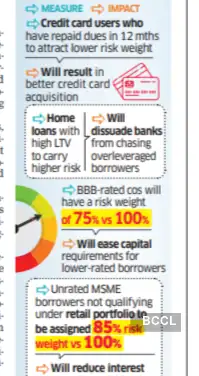Below its revised draft norms, the regulator has proposed capital necessities for bank cards, dwelling loans, company loans, actual property exposures, and MSME lending.
Among the many key modifications are simpler norms for bank card customers with well timed reimbursement histories and tighter norms for big-ticket dwelling loans.
Bank card customers who've repaid their dues in full over the previous 12 months – termed ‘transactors' – can be labeled below the regulatory retail portfolio. This can scale back the relevant threat weight to 75% from 125%, decreasing capital necessities for banks and incentivising higher high quality of acquisition by banks.

Aggressive Pricing
For different bank card customers, the danger weight will stay at 125%.
The revised norms are amongst 22 bulletins the RBI made in the course of the October financial coverage. They're scheduled to take impact from April 2027.
On dwelling loans, the regulator has proposed to align the danger weight to loan-to-value (LTV) ratios and the variety of excellent dwelling loans.
For as much as two housing loans, threat weights will vary from 20% — if the LTV is 50% — to 40% — if the LTV is above 80%. A 3rd housing mortgage will appeal to larger weights of as much as 60%, with an extra 5% surcharge for loans above ₹3 crore.
At current, housing loans appeal to a uniform 35-50% threat weight, with restricted differentiation.
The general threat weights for private loans, excluding schooling, housing, and car loans, will proceed to draw a 125% threat weight. The RBI has retained the upper capital requirement for these unsecured exposures, citing their elevated threat profile.
Senior financial institution officers mentioned the revised framework is anticipated to enhance capital effectivity for banks, particularly these with giant portfolios of low-risk secured retail loans.
It might additionally result in extra aggressive pricing for dwelling and schooling loans, whereas protecting credit score situations tight for unsecured private loans.
Below the brand new framework, BBB-rated company loans will appeal to a decrease threat weight of 75%, down from the sooner 100%, providing capital reduction to banks.
Nevertheless, unrated company exposures exceeding ₹200 crore or these beforehand rated however now unrated will proceed to draw a penal 150% threat weight, unchanged from present norms.
AA-rated company loans will appeal to 20% threat weights, down from 30% now.
For actual property builders, the RBI mentioned industrial actual estate-acquisition, growth and development (CRE-ADC) will appeal to a threat weight of 150%, up from the sooner vary of 100-125%, if such tasks are having decrease gross sales or low fairness contribution from builders.
Residential housing tasks below CRE-residential housing will appeal to a 100% threat weight, in comparison with 75% now.
Unrated MSME exposures not qualifying below the regulatory retail portfolio will appeal to a threat weight of 85%, down from 100%. MSMEs assembly retail standards will proceed at 75% threat weight.










